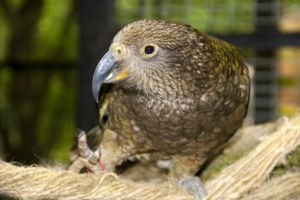Treat the family to a half-day or full day outing at a wildlife sanctuary. This is an outdoor experience for both adults and children of all ages, where the public may enjoy the fresh air and exercise, and appreciate the beauty of New Zealand’s native flora and fauna.
But what are these “wildlife sanctuaries”? How have they come about?
The invasion of predatory pests — such as rats, stoats, mice, ferrets, weasels, possums, hedgehogs, feral goats, feral cats, and dogs — have been and are progressively denuding our National Parks of wildlife. The logistics of this invasion were overwhelming to an under-resourced Department of Conservation (DOC). Confronted by a war it couldn’t win against predatory pests on the North Island and South Island, DOC decided upon a strategic retreat to small offshore islands, creating island reserves for endangered or rare wildlife species. But these remote island reserves, such as Little Barrier, Tiritiri Matangi, Kapiti, and Stephens Island, resulted in very limited public access.
Over the past 15 years many Community groups, frustrated at both the declining state of flora and fauna within our national parks and limited access to offshore island reserves, have raised funds to create fully fenced predator proof wildlife sanctuaries, enabling the the native fauna and flora to recover away from vertebrate pests and plant pests. Most of these sanctuaries have received and continue to receive additional funding from local government and/or central government.
7 great wildlife sanctuaries you can visit with your family
Here’s 7 great, predator-proof fenced, wildlife sanctuaries that are definitely worth a visit:
- Tawharanui Peninsula (90 km north of Auckland)
- Maungatautari Ecological Island (in the central Waikato)
- Rotokare Scenic Reserve (12 km east of Eltham, South Taranaki)
- Bushy Park (north west of Wanganui)
- Karori Wildlife Sanctuary (in a suburb of Wellington city)
- Brook Waimarama (near Nelson)
- Orokonui Ecosanctuary (13 km north of Dunedin, via Port Chalmers)
Tawharanui Peninsula
- 530 hectares
- 2.5 km coast-to-coast fence
- sanctuary is located within Tawharanui Regional Park which is administered by Auckland Regional
Council (ARC)
- an “open sanctuary” combining farming, public recreation and conservation of native species.
- adjoining Tawharanui Marine Park
- partnership betweeen ARC and Tawharanui Open Sanctuary Society Inc (TOSSI) which is a voluntary fundraising group
- Free to visitors
- TOSSI website: www.tossi.org.nz
Maungatautari Ecological Island
- 3,400 hectares
- 47 km fully fenced
- located in the central Waikato, between Cambridge, Te Awamutu and Putaruru
- Maungatautari mountain is an extinct volcano, with a forested peak and flanks, which is surrounded by pastoral
farmland, and embraced on two sides by the Waikato River - managed by the Maungatautari Ecological Island Trust (which includes representation from Waipa District Council, DOC, Waikato Conservation Board, local iwi, and local experts)
- Free to visitors
- Maungatautari website: www.maungatrust.org
Rotokare Scenic Reserve
- 230 hectares
- 8.4 km fully fenced
- consists of stunning forested hill-country, extensive wetlands and 17.8 hectare natural lake
- the forest is characterised by mature tawa, rewarewa and mahoe
- the lake edge habitat consists of raupo, flax, and pukatea/kahikatea swamp forest
- includes a 4km walkway around the lake, with seating at scenic points
- includes large grassed picnic areas, with toilet facilities
- includes a boat ramp for power boats (Dec. – April), canoes and kayaks.
- Free to visitors
- Rotokare’s website: www.rotokare.org.nz
Bushy Park
- 92 hectares
- 4.8 km fully fenced
- a remnant of some of New Zealands’s finest lowland native rain forest.
- home to a growing number of native birds including, the very rare and beautiful Saddleback (Tieke), Kiwi, Bush Robin, Native Pigeon (Kereru), Morepork, Tui, Bellbird, NZ Falcon, Tomtit and others
- the Park is crossed by a network of forest paths allowing you to stroll in peace
- includes an elegant Edwardian homestead which provides: an education centre for learning experiences in science, technology and the environment; a cafe; a bar; and B&B accommodation
- owned by the the Royal Forest and Bird Protection Society of New Zealand, and managed by the Bushy Park Trust
- Entrance fee for adults, free for children under 15 years
- Bushy Park’s website: www.bushyparksanctuary.org.nz
Zealandia (Karori Wildlife Sanctuary)
- 225 hectares
- consists of regenerating lowland forest and wetlands
- 8.6 km fully fenced
- located adjoining the suburb of Karori, close to central Wellington
- includes 34 km of attractive bush walking tracks
- includes our mainland’s only wild population of tuataras.
- includes Visitor & Education Centre, with a cafe, and hireage of baby buggies, backpacks
- Entrance fees — NB. Children under 5 yrs are free
- guided tour options, day and (by torchlight) night
- the old Karori Reservoir valley land is owned by Wellington City Council and managed by the not-for-profit Karori Wildlife Sanctuary Trust
- recently rebranded as “Zealandia” referring to the land (and it’s unique native flora and fauna) that broke away from Gondwanaland 85 million years ago.
- website: www.sanctuary.org.nz
Brook Waimarama
- 715 hectares
- 14 km fence — under construction
- Most of the site is mature beech forest with occasional huge podocarps but the southern part is diverse broadleaved forest
- includes a lovely walk (45 minute return) alongside the stream and 19th Century waterworks
- Vision for the sanctuary to be an integral part of a solution for birdlife in the Nelson region — a forested corridor connecting birdlife with residents’ gardens and with neighbouring native forest, including the Mt Richmond Conservation Area.
- free to visitors
- owned by Nelson City Council, and managed by the Brook Waimarama Sanctuary Trust, which includes representatives from DOC, NMIT (Nelson Marlborough Institute of Technology), local iwi, and other individuals.
- Brook Waimarama website: www.brooksanctuary.org
 Orokonui Ecosanctuary
Orokonui Ecosanctuary
- 307 hectares
- includes 230 hectares of Nature Reserve — i.e. conservation land that has been given the highest category of protection
- 10 km fully fenced
- home to native wildlife including South Island tit, South Island rifleman, brown creeper, bellbird, grey warbler,
fantail, Haast tokoeka kiwi, takahe, South Island kaka, ruru, South Island robin, South Island saddleback, fernbird, tui, kereru, Otago jewelled gecko and native eel. - Includes tracts of old podocarp forest; totara, miro, matai, rimu
- Visitor and Education Centre was completed in 2009 – it includes interpretive and interactive displays.
- includes a network of tracks of various grades providing good access to points of interest in the sanctuary
- Access is through guided tours and self-guided walking
- Extensive Education Programme for all ages pre-schoolers to seniors.
- Entrance fees
- owned and managed by the Otago Natural History Trust
- Orokonui’s website: www.orokonui.org.nz
Vast amounts of time, effort, and money have been expended in the creation of and ongoing maintenance of these sanctuaries. But what is it all for? The main overall goal is to restore an eco-system (including flora and fauna) to it’s pre-human state, before the invasion of pests introduced by humans, for the preservation of endangered species, and for public appreciation.
Fauna or wildlife at risk:
|
|
|
|
| Hihi (stitchbird) |
|
|
|
|
|
|
|
|
|
|
|
|
|
|
|
|
|
|
|
Useful Websites
Sanctuaries of New Zealand website lists 49 different sanctuaries around New Zealand, including the fenced sanctuaries above, each with the aim to restore an ecosystem to a state dominated by diverse and abundant native species and their interactions.
This excellent website of New Zealand Birds contains a colourful directory of all our birds — endemic, native, introduced, and extinct; their birdsong; and a map of prominent birding sites around NZ.
The “What Bird?” website contains an easy-to-use bird identification database of 51 exotic and native bird species that are likely to be encountered in and around NZ forests.

The DOC website contains a section on New Zealand’s native animals, including a sub-section each on Birds; Reptiles & Frogs; Bats; Freshwater Fish; Invertebrates; Marine Mammals; and Sharks.

The DOC website contains a section on New Zealand’s native plants, with 28 sub-sections, including Beech Forest; Ferns; Flax; Podocarp-hardwood Forests; and Rata.

The DOC website contains a section on New Zealand’s conservation threats, including Animal pests; Weeds; and Fire.














